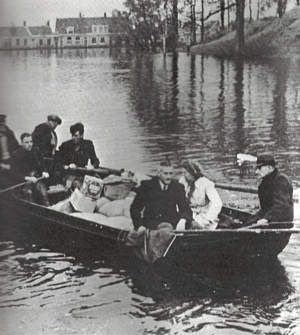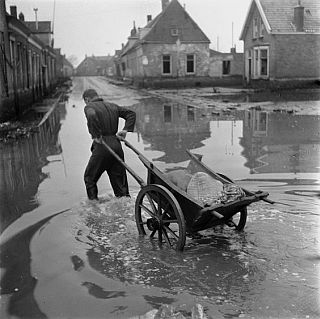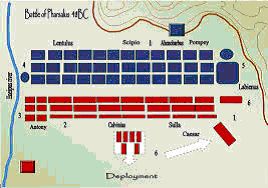


David Scholtz spoke for a few minutes about the day trip he was sponsoring to the annual Boer 'n Brit day at Val which will take place on Saturday 10th March.
Chairman Jan-Willem Hoorweg gave the curtain-raiser lecture, addressing the meeting on the subject "Water als Wapen", referring specifically to the Allies' deliberate inundation in October 1944 of the island of Walcheren which formed an important part of the defensive Atlantikwall in German-occupied Netherlands.
The coastline from Vlissingen (Flushing) to Westkapelle dominates the entrance of the river West Scheldt which was the entrance to one of the largest ports on the west coast of Europe, Antwerp. The Allies could not yet use Antwerp as part of their supply lines because the Germans occupied Walcheren.
The island itself can be thought of as a saucer with a rim of dunes and dikes. During WWII the Germans had built two lines of bunkers, one which was right on top of the dunes and dikes at the seaside and a second line about 1 to 2 kilometers inland. The purpose of the second line of bunkers was to protect the more important coastline bunkers from attacks from land. This second line consisted of bunkers and anti-tank canals and other anti-tank defenses. Over 300 bunkers dotted this landscape, of which many are still standing today.
The solution the allied forces chose was bombing the dunes and dikes at four locations, near Vlissingen, Westkapelle, Veere and Ritthem, at the beginning of October 1944. This would open the 'rim' of the saucer and the island would be inundated, thus rendering the second German defence lines useless. The Allies would then be able to use their huge amphibian capability to penetrate into the hinterland.
Warning notices were dropped by black-painted B17 bombers on the 2nd of October but, strangely, the aircraft did not fly over Westkapelle, where the first bombs would fall. This resulted in a number of casualties. No fewer than 243 attacking aircraft were seen on the afternoon of the 3rd October 1944. Never had the RAF operated in such numbers over Dutch territory for the same goal. Mostly 1800 kg bombs were used, many with time-delayed fuses.
The people in the villages accepted their fate with resignation. A journalist on his way to one of these villages notes: "we paddle in canoes ... the seal now replaces the farm dog and takes a nap on one of the dwelling mounds. Fishing became good, as the low tide trapped fish everywhere, from ponds to garden fences. From the ponds one could flip the fish out with a rake, but you had to be careful not to slip and fall in the water, everything was muddy. Mussels could be scraped off the homes, but trees for some reason survived for a long time, even being full of blossoms in Spring the following year." That was the last time they would blossom, though.
Depending on the tide, the depth of water could be anything from thirty centimetres to four metres. Some of Jan-Willem's slides showed people wearing clogs and traditional costumes as they went about their daily business in boats.


The Germans on Walcheren comprised mostly men previously exempt from military service due to stomach ailments or injuries. They were put together in the 70th Infantry Division, and given a special diet including white bread, milk and noodles. This unit of convalescents under the command of Lt Genl Daser acquitted themselves rather well in the defence of Walcheren, but were ultimately no match for the vastly superior force of amphibian units of the II Canadian Corps. Around 10 000 prisoners were subsequently marched off, probably much relieved that their boring diet was over as well. On the 8th of November all of Walcheren was cleared of Germans. (See the August 2001 Newsletter about the 'white bread division', a curtain raiser talk by Jan-Willem's father, Flip Hoorweg, in July 2001).
Only in January 1946 would the last gap in the seawall, at Rammekens, be closed off. The changes in the landscape are very well visible today. On all four locations inland lakes were created by the power of the incoming water. Walcheren emergd from the flooding and suffered very little from the great flood of 1953. The work on the dykes in Walcheren was made possible by the experience the Dutch gained in the closing off of the Ijsselmeer and the construction of the Afsluitdijk connecting North Holland with Friesland.
Around 450 Allied soldiers would pay the ultimate price in the operation, 300 German soldiers died.
Ending his lecture, Jan-Willem asked if it had all been necessary?
Judge John Myburgh, who has spoken to the Society on several occasions in the past, was the evening's main speaker. His subject was "DRESDEN: 13 FEBRUARY 1945" and he opened his lecture with a sound recording of a Lancaster bomber. Its steady droning was a somber introduction to a thought-provoking lecture, the text of which has been loaded in full onto the Society's web-site: (www.samilitaryhistory/lectures.dresden.html)
Dresden the City
Dresden "...had a long history as the capital and royal residence for the Electors and Kings of
Saxony, who for centuries furnished the city with cultural and artistic splendor. The city was
known as the Jewel Box, because of its baroque and rococo city centre." (Wikipedia)
In 2006 Dresden celebrated its 800th anniversary. This was a valued destination for
noblemen on the European "Grand Tour".
Amongst other quotes - Sven Lindquist: "Dresden was the Florence of Germany - an old
cultural capital, full of art treasures and architectural masterpieces that the bombing had left
untouched throughout five years of war."
On the 13/14 February 1945 almost 4000 tons of bombs were dropped on Dresden in
less than 24 hours. There was a firestorm which destroyed the city centre and unleashed
subsequent criticism of the bombing of civilian targets which is debated to this day.
Casualties of 25 000 upwards having been killed (Goering claimed ten times that number for propaganda value) were claimed; 39 773 deaths were officially registered but the firestorm made identifying the dead impossible.
Damages: 75 000 out of 220 000 homes were destroyed and 18 500 severely damaged.
Then John turned to the meat of his paper:
- the justification provided for the bombing of Dresden before and after the bombing
Our speaker referred to various attempts to limit the use of aerial bombing where civilian casualties would most probably result - going back to the Hague Convention of 1907; the Washington Disarmament Conference in 1922; the Hague (1923) Rules for Air Warfare - although they were not ratified by any of the WWII combatants - were accepted as the de facto restraint.
In 1932 the Geneva Disarmament Conference saw Spain wanting the banning of all military aircraft; The Netherlands against all aerial bombardment and the Czech Foreign minister wanting air attack against the civilian population to be absolutely prohibited.
Even Hitler seemed to be against the bombing of women and children, as shown by his 1936 'peace plan' and his comments to Chamberlain in September 1938. On the same day the League of Nations confirmed the main provisions of The Hague Rules drawn up fifteen years before - as reported in 2013, although the resolution was not legally binding, it was regarded as if it represented collective legal opinion.
There were loud condemnations of the raid on both sides of the Atlantic, including questions in the British Parliament, and in due course a range of "reasons" was paraded to justify the operation: - being in retaliation and revenge for the bombing of British cities during the Blitz; - to break morale; - to shorten the war; - to defeat Germany; - to make a contribution to the war effort at a time when the Soviet Union was on its own fighting the German army on the Eastern Front.
For example, examining the idea of the bombing being in revenge for the attacks on Britain shows a huge imbalance when it is revealed that in one week Bomber Command [and the USAAF] had killed more people in the Hamburg attacks than the Luftwaffe had achieved in the eight months of the Blitz in England in 1940-41. Totals for the whole War show five to ten times more German civilians killed than Allied ones.
Similarly, the assertion that it had been at the request of the Soviets is refuted by the minutes of the Yalta conference - Dresden was NOT included in the targets discussed. With the benefit of hindsight, the timing of the raid - early 1945 - when the Germans were to surrender a few months later, was also criticised, since it was argued that German defeat was inevitable and extra casualties unnecessary.
Quoting many contemporary papers John outlined how the public reaction led to politicians, including Winston Churchill, removing their previous approval of the practice of area bombing. Arthur "Bomber" Harris, the commander-in-chief of Bomber Command, felt betrayed by what he saw as an about-turn on the policy - which he felt was necessary to shorten the war and save Allied combatants.
Dresden was not the first German city to suffer a firestorm - John outlined the destruction of Hamburg in 1943 in which 9 000 tons of bombs had been dropped, resulting in the single largest loss of civilian life in one city throughout the whole European war, exceeded only by the 250 000 Japanese killed in the firebombing of Tokyo and the atomic attacks on Hiroshima and Nagasaki.
While all parties were quoted as being clearly against the destruction of any civilian life, by 1942 attitudes were leaning towards the acceptance of the inevitability of some civilian casualties and by the end of 1944 the "wider" aims were simply accepted as being more important than avoiding the deaths of civilians - the slippery slope had taken over.
Both speakers were suitably thanked by Deputy Chairman Hamish Paterson.
This serves as notice that the 52nd AGM of the Society will take place
in the J.C. Lemmer Auditorium at the Ditsong National Museum of Military History
at 20h00 on Thursday 12th April 2018.
Agenda:

Johannesburg:
CR= curtain raiser; ML= main lecture; DDH = Darrell D Hall Memorial Lecture;
Branch contact details
For Cape Town details contact Johan van den Berg 021-939-7923 warbooks@mweb.co.za
For Eastern Cape details contact Malcolm Kinghorn 041-373-4469 culturev@lantic.net
For Gauteng details contact Joan Marsh 010-237-0676 joan@rfidradar.com
For KwaZulu-Natal details contact Roy Bowman 031 564 4669 bowman.roy93@gmail.com
* NOTE*
Fast mirror and backup site BOOKMARK
FOR REFERENCE Main
site * NOTE*